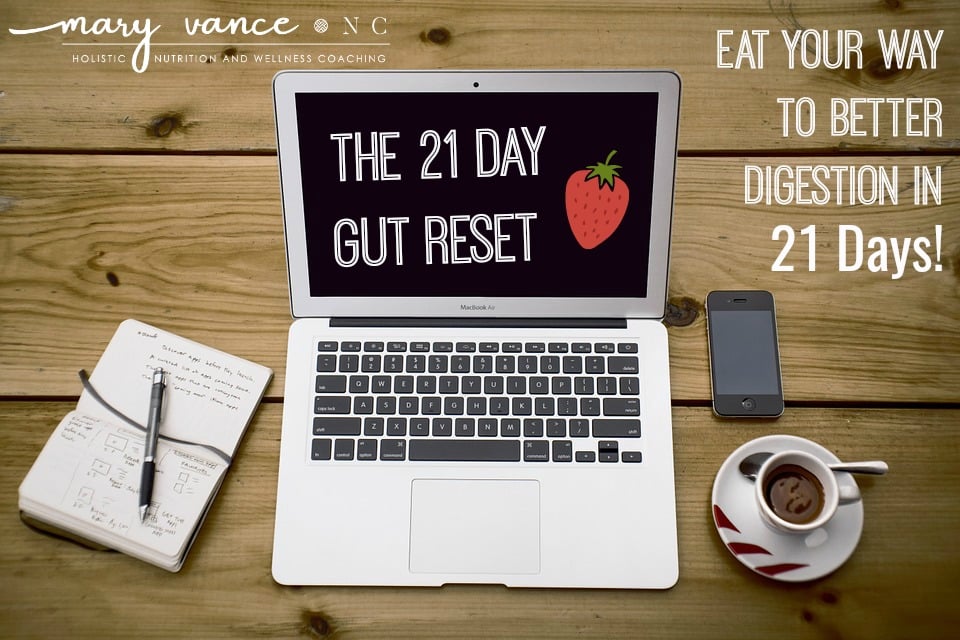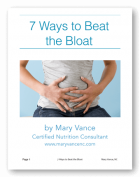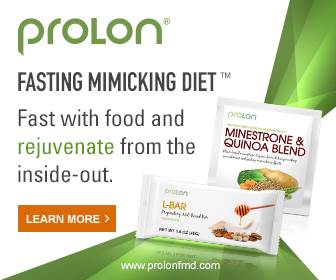If you have digestive issues, no doubt your doctor told you to eat more fiber. But if you suffer with bloating, constipation or SIBO, eating more fiber can make you feel much worse. What gives?
Conventional dietary guidelines tell us to eat more fiber for optimal health. 25 grams is the standard, but holistic health practitioners and nutritionists recommend you double that and aim for 50 grams. For scale, 1 cup of beans averages about 15-20 grams; 1 cup of broccoli is about 3 grams.
Spoiler alert: dietary guidelines certainly don’t apply to everyone since we all inhabit different bodies and have unique dietary needs.
We’ve been told that high fiber diets help us poop regularly and correlate to reduced risk of cardiovascular disease, type 2 diabetes, colon cancer, and obesity. (source) But we are actually not certain whether that decreased risk is due to the high fruit and vegetable intake (which we know reduces disease risk due to antioxidants), or if it is actually due to the fiber itself. If you’re consuming a lot of fiber, you’re eating a lot of plants which have an array of nutrients that happen to be anti-inflammatory (a main factor in disease prevention) and rich in the antioxidant vitamins A, C, E, and zinc that prevent disease.
But for some people, eating a higher fiber diet actually causes constipation, stomach pain, and bloating. Often these folks have tried to increase fiber by eating whole grains and beans, only to find these foods stop them up and worsen stomach pain.
What if, for some of us, eating more fiber isn’t the answer to digestive problems?
What Is Fiber
Fiber is an undigestible (to you) carbohydrate that cannot be broken down into sugar molecules like other carbs. Rather, fiber passes through your stomach and small intestine and is broken down and fermented by your gut bacteria when it reaches your colon (large intestine). Eating fiber adds bulk to stool, and in certain bodies, it does promote regularity. But this depends on your personal gut bacteria (more on that later).
There are two types of fiber:
- Soluble fiber dissolves and binds with toxins for excretion and is said to lower blood sugar and prevent inflammation (but again, it hasn’t been proven that the fiber itself does this; could also be the nutrients in the plants containing the fiber. source) Soluble fiber dissolves in water (hence its solubility) and gastrointestinal fluids when it enters the stomach and intestines. It is transformed (but not broken down) into a gel-like substance, which is then digested by the bacteria that live in your large intestine, releasing gases and a few calories. Includes beans, avocado, psyllium, sweet potato (and all root veggies), banana, figs, cruciferous veggies like Brussels sprouts, kale, broccoli.
- Insoluble fiber adds bulk to stool so it passes through the colon and is high in the prebiotic material needed to feed your probiotics. You can’t digest this type of fiber, but your gut bacteria love it. Think tough outer skins (like apple and cucumber skin). Cabbage, lettuce, peas, and bell peppers are also good sources.
Could a Low Fiber Diet Help Your Digestive Problems?
High fiber diets can cause a lot of trouble for those with digestive disorders or inadequate gut bacteria (AKA poor probiotic diversity). Because your probiotic gut bacteria break down fiber for you, if you don’t have enough of these guys, they won’t be able to work for you to break down fiber. You may experience painful bloating, gas, and constipation when the fiber isn’t broken down properly. I see this regularly in my practice, especially with people who have had SIBO or taken many rounds of antibiotics.
“Sherry” came to see me complaining of life-long constipation, bloating, and feeling like food sat in her stomach like a brick after she ate. Her doctor told her to eat more fiber, which hadn’t worked. She would get more bloated and constipated. She added psyllium husk (main ingredient in Metamucil) to help, and that caused pain so severe she was doubled over. She was understandably confused about why this was happening when she was doing all the “right things.”
We did some testing and found out Sherry had SIBO, a condition where bacteria make a home in the wrong part of the digestive tract, the small intestine. These bacteria ferment fibers that enter the small intestine and release gases that cause sever bloating and constipation. Remember, fiber shouldn’t be processed and fermented until it reaches the large intestine, so if bacteria are trapped in the small intestine, they are doing their job too early. Unpleasant symptoms result. (read more about SIBO here).
If you have SIBO, adding more fiber will make your symptoms and the bacterial overgrowth much worse. Once we started Sherry on a low fiber, higher fat, moderate protein diet and addressed the SIBO, she felt MUCH better. Bacterial overgrowths like SIBO and candida that cause a gut flora imbalance are two examples where more fiber makes the person feel much worse and can actually hinder healing.
Another example is Irritable Bowel Syndrome (IBS). While 40-50% of IBS cases are actually caused by SIBO, IBS can also be caused by antibiotics, certain strains of bacteria, or even stress. Often IBS may occur with no obvious cause.
Irritable Bowel Disease, such as Crohn’s, and diverticulitis are other instances in which high fiber is not recommended. These folks will feel better on a keto type diet or high protein low carb diet until the gut is healed.
Fiber May Worsen Certain Digestive Conditions
Carbohydrates can be very difficult to break down in those with compromised digestion: SIBO, IBS, and leaky gut, for example. Although fiber passes through the small intestine relatively undigested, starches in plants, especially FODMAP starches, can irritate the small intestine and worsen SIBO, IBS, and leaky gut, causing bloating and constipation or diarrhea. If you have the following digestive disorders, a high fiber diet, meaning over 25 grams of fiber, may make you feel worse:
- SIBO
- IBS
- IBD
- Diverticulitis
- Candida
- Constipation
- Bloating
Feeling worse could mean a flare-up, worsening in bloating, not being able to poop, or severe stomach pain. A low fiber diet is a good solution while you work on healing your gut and slowly increasing bacterial species to help you better digest carbs down the line. Reducing fiber gives your gut a break from starches that can be very irritating to the small intestine and colon when you have digestive issues.
How to Eat a Low Fiber Diet
Eating low fiber means about 10 grams of fiber per day. Carbs are the foods that contain fiber, so you’ll be cutting down on carbohydrates. (Remember, anything that is not a protein or a fat is a carb). Make carbs about 10-15% of your daily intake.
When you cut down on one macronutrient like carbs, you’ll need to increase one of the other macronutrients, fat or protein (but not both). Some people do well on a keto diet which is low carb, high fat, moderate protein. Fat may help stimulate bowel movements if you have trouble with constipation. Or you could do high protein, moderate fat, low carb. The point is if you are lowering carbs you need to increase something else to make up for it. Fiber does increase fullness, so if you are not eating enough fat or protein with a low fiber diet, you’re going to be hungry.
Those with SIBO and IBS may do well on a low FODMAP diet. While not necessarily low fiber, a low FODMAP diet excludes fermentable starches that are difficult to break down if you leaky gut, SIBO, or IBS. Read more about FODMAPs here.
I do not recommend a low fiber diet long term, as reducing fiber for long periods of time starves your beneficial gut bacteria that work for you to prevent disease and help you digest your food. The idea is to reduce fiber while you address the reason you cannot digest large amounts of fiber. Then you want to gradually up your plant intake over time.
Low fiber foods to include:
- Fats: butter, ghee animal fat, olive oil, avocado oil, coconut oil, sesame oil
- Protein: seafood, meat, poultry, eggs
- Low fiber carbs: white rice, mixed greens and lettuce, small amounts of green beans and cooked greens, potatoes without skins, summer squash, spaghetti squash. Focus on cooked vegetables.
Avoid grains, legumes, berries, dried fruit, nuts, pop corn, starchy root vegetables, potatoes with skins.
An example low fiber diet may look like this (quantity varies based on your size, age, gender):
Breakfast: 2-4 eggs, 2 organic sausages, side of raw kraut for probiotics
Lunch: bone broth soup with shredded chicken, spices, zucchini, shredded carrot
Snack: green juice with collagen protein
Dinner: white rice or skinless potato with salmon
What About Colon Cancer?
For years, we’ve been told to consume a high fiber diet to lower the risk of colon cancer (and there are many studies that “prove” this), but most recent studies have largely failed to show a link between fiber and colon cancer. One of these—a Harvard study that followed over 80,000 female nurses for 16 years—found that dietary fiber was not strongly associated with a reduced risk for either colon cancer or polyps, a precursor to colon cancer. (source) One theory is perhaps the participants weren’t eating enough fiber.
Fiber & Heart Disease
So the Harvard studies did not find that fiber reduces the risk of colon cancer. But they have confirmed many other benefits of fiber, even in moderate amounts. For example, the Health Professionals Study of 43,757 men found that fiber reduces the risk of heart disease. Over six years, the men who ate the most fiber (averaging 28.9 grams a day) enjoyed a 41% reduction in heart attacks compared to the men who ate the least (12.4 grams a day). All in all, for each 10 gram increase, a man’s risk of heart disease drops by 19 percent. (source)
It’s really hard to tell with these types of studies what is lowering disease risk. Is it the fiber itself? Is it the nutrients in the plants people eat to get the fiber? Is it because people who eat more vegetables and fruits are more likely take better care of themselves in other areas of their lives, like exercising more? Is it because the fiber is increasing their regularity so they’re pooping more and not suffering with constipation that can cause increases toxic load in the body? Is it a combo of all these factors? As you can see, it can be difficult to determine the golden egg in nutrition studies.
Conclusion
A low fiber diet can really help relieve your symptoms if you suffer with chronic constipation, bloating IBS, IBD, candida, or SIBO. Consider stool testing to see what’s going on in the gut and to get an idea if your beneficial bacterial strains are low, a main cause of not being able to properly digest fiber and fibrous foods. I recommend the GI MAP which you can order here.
The takeaway here is that more fiber is not always the answer for people with digestive issues. General dietary guidelines do not work for everyone. ‘Eat more fiber’ is one of the oldest pieces of diet advice around. And while increasing fiber may help some folks, certain digestive disorders or symptoms may call for a low fiber diet until the gut is healed and fiber can be slowly increased over time.
Our ability to digest foods efficiently depends on our gut bacteria and unique genome. Kale might be a superfood for me, but it might cause painful gas and bloating in another person. (read more about boosting your gut flora here)
I don’t recommend a long term low fiber diet. Typically if you cannot handle 25 grams of fiber daily, there is some type of underlying digestive disorder or bacterial imbalance like dysbiosis (too much bad bacteria and not enough good bacteria), SIBO, or candida. You can do stool testing (SIBO requires a breath test) to get a picture of what’s happening in the gut to normalize and boost your good gut flora and get rid of bad bacteria.
Pin it!

Mary Vance is a Certified Nutrition Consultant and author specializing in digestive health. She combines a science-based approach with natural therapies to rebalance the body. In addition to her 1:1 coaching, she offers courses to help you heal your gut and improve your health. Mary lives in San Francisco and Lake Tahoe in Northern California. Read more about her coaching practice here and her background here.









Hellow this is very very good articul you are Genius thanks
This really helped me a lot , thank you